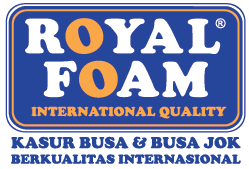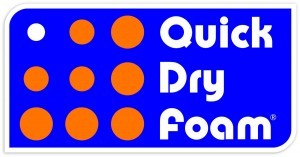SOURCING.FURNITURE
THE KEY TO HIGH QUALITY FURNITURE IN INDONESIA
What quality of FOAM do you need, how about FABRIC, which grade of Wood, Stainless, Finishing?
The key of success is to get the best mix of materials in order to match your market's expectations.
There are plenty of possibilities to craft your dream piece of furniture.
At Sourcing.Furniture we never compromise the quality of workmanship, but we can mix materials in order to meet the needs of all our partners.
OUR FURNITURE MATERIALS
Our only goal is to deliver quality. To do so, we only work with the best in the industry for both manufacturers and raw materials suppliers.
Quality is the end result of the joint forces of all elements brought together.
Indonesian furniture suppliers can be the most skilled in the world, but if the materials they use is not do not match the same high standards than their workmanship, it is a waste.
Ps: Any lower quality in material should only be a strategical choice.
Why Quality Matters?
Wood: In wood, we have to look into 3 main principles:
Final use of the furniture: indoor, outdoor, kitchen, or bathroom, the material chosen will have to be in accordance with the furniture final destination. The final choice of material can also be impacted by the climate type in its adoptive country.
Moisture Content: The moisture content in wood plays an important role in the quality of the final product. The lower the better, mostly if the furniture is exported to countries where seasons are characterized by important change of temperature and humidity. If through time, the water contained in the wood freezes in winter, dries up in summer, the whole furniture structure would be stressed and might break, or even explode (true story of a container of wooden chairs exported to France, where the chairs, once properly displayed in a brand new restaurant, started to explode by themselves, one after the other).
Wood grade: The wood grade has mostly an aesthetic impact. Even though, public thinking believes that the highest the grade the better, some prefer lower grades as it gives more character to the final product.
However, by going for a lower grade, it is important to choose carefully which wooden piece to be used for which component. Dead knots or live knots may threaten the strength of the component and should, therefore, not be used in load bearing pieces of the furniture.
Textile: The quality of the fabric and foam used in a piece of furniture is also key to its long lasting life. Mostly in outdoor use, the sun, the rain and snow are putting the fabric through challenging tests. For the fabric, it is important to use UV protected materials so it does not loose its color and texture. Regarding the foam, using foam like Urecel Quick Dry Foam is key has it does not retain water or humidity in the cushion which allows it to dry quickly in order to not rot.
For some countries, a Fire Retardant fabric and foam is required for insurance matters and should then be considered while purchasing furniture in Indonesia.
Wicker: Viro and Rehau are the most commonly used synthetic wicker in furniture manufacturing in Indonesia. Those brands offer life guarantee on their materials. However, to reach lower costs, some rattan furniture manufacturers, mostly in China, produce their own wickers which have a way shorter life cycle; they quickly loose their colors and the fibers deteriorate quickly which impacts the whole weaving works and so, the strength of the whole piece of furniture.
Ps: Any lower quality in material should only be a strategical choice.
Why Quality Matters?
Wood: In wood, we have to look into 3 main principles:
Final use of the furniture: indoor, outdoor, kitchen, or bathroom, the material chosen will have to be in accordance with the furniture final destination. The final choice of material can also be impacted by the climate type in its adoptive country.
Moisture Content: The moisture content in wood plays an important role in the quality of the final product. The lower the better, mostly if the furniture is exported to countries where seasons are characterized by important change of temperature and humidity. If through time, the water contained in the wood freezes in winter, dries up in summer, the whole furniture structure would be stressed and might break, or even explode (true story of a container of wooden chairs exported to France, where the chairs, once properly displayed in a brand new restaurant, started to explode by themselves, one after the other).
Wood grade: The wood grade has mostly an aesthetic impact. Even though, public thinking believes that the highest the grade the better, some prefer lower grades as it gives more character to the final product.
However, by going for a lower grade, it is important to choose carefully which wooden piece to be used for which component. Dead knots or live knots may threaten the strength of the component and should, therefore, not be used in load bearing pieces of the furniture.
Textile: The quality of the fabric and foam used in a piece of furniture is also key to its long lasting life. Mostly in outdoor use, the sun, the rain and snow are putting the fabric through challenging tests. For the fabric, it is important to use UV protected materials so it does not loose its color and texture. Regarding the foam, using foam like Urecel Quick Dry Foam is key has it does not retain water or humidity in the cushion which allows it to dry quickly in order to not rot.
For some countries, a Fire Retardant fabric and foam is required for insurance matters and should then be considered while purchasing furniture in Indonesia.
Wicker: Viro and Rehau are the most commonly used synthetic wicker in furniture manufacturing in Indonesia. Those brands offer life guarantee on their materials. However, to reach lower costs, some rattan furniture manufacturers, mostly in China, produce their own wickers which have a way shorter life cycle; they quickly loose their colors and the fibers deteriorate quickly which impacts the whole weaving works and so, the strength of the whole piece of furniture.
SOLID WOOD
Merbau
Common Name(s): Merbau, Kwila, Ipil Scientific Name: Intsia spp. (I. bijuga, I. palembanica)
Distribution: From East Africa to Southeast Asia and Australia;
(primarily New Guinea)
Tree Size: 130-200 ft (40-60 m) tall, 4-5 ft (1.2-1.5 m) trunk diameter
Average Dried Weight: 51 lbs/ft3 (815 kg/m3)
Specific Gravity (Basic, 12% MC): .68, .82
Janka Hardness: 1,840 lbf (7,620 N)
Modulus of Rupture: 21,060 lbf/in2 (145.2 MPa)
Elastic Modulus: 2,310,000 lbf/in2 (15.93 GPa)
Crushing Strength: 10,650 lbf/in2 (73.4 MPa)
Shrinkage: Radial: 2.9%, Tangential: 4.8%, Volumetric: 8.0%, T/R Ratio: 1.7
Color/Appearance: Has an orangish-brown color when freshly cut, which ages to a darker reddish-brown. Color between boards can be highly variable. There are also small yellow mineral deposits found throughout the wood, making it easier to separate from other lookalikes. (These yellow deposits are water-soluble and can cause staining.)
Grain/Texture: Grain is straight to interlocked. Texture is coarse, with a moderate natural luster.
Endgrain: Diffuse-porous; large to very large pores, very few; solitary and radial multiples; mineral deposits occasionally present, including conspicuous yellow deposits; narrow rays, normal spacing; parenchyma banded (marginal), paratracheal parenchyma vasicentric, aliform (winged or lozenge), and confluent.
Rot Resistance: Merbau is reported to be very durable, and resists both rotting and insect attack.
Workability: Glues and finishes well, though it can be difficult to saw due to gumming and dulling of teeth.
Odor: Has a unique smell when being sawed or sanded: which can also cause irritation and sneezing.
Allergies/Toxicity: Merbau has been associated with mild allergic reactions: most common is skin irritation and a runny nose. See the articles Wood Allergies and Toxicityand Wood Dust Safety for more information.
Pricing/Availability: Offered sporadically, lumber is usually sold in ample widths and lengths when available. Prices should be moderate for an imported hardwood.
Sustainability: This wood species is not listed in the CITES Appendices, but is on the IUCN Red List. It is listed as vulnerable due to a population reduction of over 20% in the past three generations, caused by a decline in its natural range, and exploitation.
Common Uses: Flooring, furniture, musical instruments, turned objects, and other specialty wood items.
Comments: This wood has excellent strength characteristics, along with excellent stability, making it ideally suited for use as wood flooring and other applications where strength is important.
source: http://www.wood-database.com/merbau/#pics
Distribution: From East Africa to Southeast Asia and Australia;
(primarily New Guinea)
Tree Size: 130-200 ft (40-60 m) tall, 4-5 ft (1.2-1.5 m) trunk diameter
Average Dried Weight: 51 lbs/ft3 (815 kg/m3)
Specific Gravity (Basic, 12% MC): .68, .82
Janka Hardness: 1,840 lbf (7,620 N)
Modulus of Rupture: 21,060 lbf/in2 (145.2 MPa)
Elastic Modulus: 2,310,000 lbf/in2 (15.93 GPa)
Crushing Strength: 10,650 lbf/in2 (73.4 MPa)
Shrinkage: Radial: 2.9%, Tangential: 4.8%, Volumetric: 8.0%, T/R Ratio: 1.7
Color/Appearance: Has an orangish-brown color when freshly cut, which ages to a darker reddish-brown. Color between boards can be highly variable. There are also small yellow mineral deposits found throughout the wood, making it easier to separate from other lookalikes. (These yellow deposits are water-soluble and can cause staining.)
Grain/Texture: Grain is straight to interlocked. Texture is coarse, with a moderate natural luster.
Endgrain: Diffuse-porous; large to very large pores, very few; solitary and radial multiples; mineral deposits occasionally present, including conspicuous yellow deposits; narrow rays, normal spacing; parenchyma banded (marginal), paratracheal parenchyma vasicentric, aliform (winged or lozenge), and confluent.
Rot Resistance: Merbau is reported to be very durable, and resists both rotting and insect attack.
Workability: Glues and finishes well, though it can be difficult to saw due to gumming and dulling of teeth.
Odor: Has a unique smell when being sawed or sanded: which can also cause irritation and sneezing.
Allergies/Toxicity: Merbau has been associated with mild allergic reactions: most common is skin irritation and a runny nose. See the articles Wood Allergies and Toxicityand Wood Dust Safety for more information.
Pricing/Availability: Offered sporadically, lumber is usually sold in ample widths and lengths when available. Prices should be moderate for an imported hardwood.
Sustainability: This wood species is not listed in the CITES Appendices, but is on the IUCN Red List. It is listed as vulnerable due to a population reduction of over 20% in the past three generations, caused by a decline in its natural range, and exploitation.
Common Uses: Flooring, furniture, musical instruments, turned objects, and other specialty wood items.
Comments: This wood has excellent strength characteristics, along with excellent stability, making it ideally suited for use as wood flooring and other applications where strength is important.
source: http://www.wood-database.com/merbau/#pics
Mahogany
- Density: 785 kg/m3
- Hardness: 3600 N
- Volumetric Shrinkage: 17.4
Description:
Mahogany wood grows on many places in the world. The mahogany we use is Toona Sureni, which is native to Indonesia. The mahogany tree can grow up to 50 meter tall. The stems in Indonesia usually have a diameter of max 60cm.
The leaves of the mahogany tree are pinnate with a length of approximately 40cm. Mahogany trees have small fruits of about 3cm that contain seeds and can't be eaten.
Mahogany is originally colored red. Since this color is not desirable the wood is mostly finished in a darker color. There's also the option to bleach the mahogany and then finish it in a teak-like color.
Origin:
The mahogany wood comes, like the teak wood, from government protected plantations.
Uses:
Mahogany wood can be used with clear or colored finishing. With clear finishing you will still see the red glow that mahogany still has. A solution for this is to finish it with a dark brown stain. For colored finishing mahogany is our first choice because of its strength.
Teak
Common Name(s): Teak, Burmese Teak
Scientific Name: Tectona grandis
Distribution: Native to southern Asia;
Widely grown on plantations throughout tropical regions of Africa, Asia, and Latin America.
Tree Size: 100-130 ft (30-40 m) tall, 3-5 ft (1-1.5 m) trunk diameter
Average Dried Weight: 41 lbs/ft3 (655 kg/m3)
Specific Gravity (Basic, 12% MC): .55, .66
Janka Hardness: 1,070 lbf (4,740 N)
Modulus of Rupture: 14,080 lbf/in2 (97.1 MPa)
Elastic Modulus: 1,781,000 lbf/in2 (12.28 GPa)
Crushing Strength: 7,940 lbf/in2 (54.8 MPa)
Shrinkage: Radial: 2.6%, Tangential: 5.3%, Volumetric: 7.2%, T/R Ratio: 2.0
Color/Appearance: Heartwood tends to be a golden or medium brown, with color darkening with age.
Grain/Texture: Grain is straight, though it can occasionally be wavy or interlocked. Coarse, uneven texture and moderate to low natural luster. Raw, unfinished wood surfaces have a slightly oily or greasy feel due to natural oils.
Endgrain: Ring-porous or semi-ring-porous; large to very large solitary earlywood pores, medium to large latewood pores, few; solitary and in radial multiples of 2-3; tyloses and other heartwood deposits (light-colored) common; medium rays visible without lens, spacing normal; parenchyma vasicentric, and banded (marginal), with bands sometimes wide enough to enclose entire earlywood pores.
Rot Resistance: Teak has been considered by many to be the gold standard for decay resistance, and its heartwood is rated as very durable. Teak is also resistant to termites, though it is only moderately resistant to marine borers and powder post beetles.
Workability: Easy to work in nearly all regards, with the only caveat being that Teak contains a high level of silica (up to 1.4%) which has a pronounced blunting effect on cutting edges. Despite its natural oils, Teak usually glues and finishes well, though in some instances it may be necessary to wipe the surface of the wood with a solvent prior to gluing/finishing to reduce the natural oils on the surface of the wood.
Odor: Teak can have a leather-like scent when freshly milled.
Allergies/Toxicity: Although severe reactions are quite uncommon, Teak has been reported as a sensitizer. Usually most common reactions simply include eye, skin, and respiratory irritation, as well as other health effects, such as pink eye, rash, nausea, asthma-like symptoms, and vision effects. See the articles Wood Allergies and Toxicity and Wood Dust Safety for more information.
Pricing/Availability: Despite its widespread cultivation on plantations worldwide, Teak is very expensive. It is perhaps one of the most expensive lumbers on the market, at least for large-sized, non-figured wood. Other woods are more expensive, but are typically only available in small pieces, (i.e., Gaboon Ebony or Snakewood), or they are valued solely for the figure of their grain (i.e., burl woods, Pommele Sapele, or Waterfall Bubinga).
Sustainability: This wood species is not listed in the CITES Appendices or on the IUCN Red List of Threatened Species.
Common Uses: Ship and boatbuilding, veneer, furniture, exterior construction, carving, turnings, and other small wood objects.
Comments: Sometimes called Burmese Teak, this name is used to differentiate natural-grown trees (typically from Myanmar, aka Burma) from Teak grown on plantations. Used extensively in India and within its natural range for centuries, Teak has grown into a worldwide favorite. With its superb stability, good strength properties, easy workability—and most of all, its outstanding resistance to decay and rot—it's no wonder that Teak ranks among the most desired lumbers in the world.
Much like the many names and knockoffs of Mahogany, the moniker "Teak" has been affixed and assigned to a number of different woods seeking acclaim. The usual procedure is to take a wood bearing any degree of resemblance to Teak and insert a geographical location in front of the name. For instance, Cumaru is sometimes referred to as Brazilian Teak, while Rhodesian Teak bears little botanical relation to real Teak—Tectona grandis. The name Burmese Teak, however, does refer to genuine Teak.
Scientific Name: Tectona grandis
Distribution: Native to southern Asia;
Widely grown on plantations throughout tropical regions of Africa, Asia, and Latin America.
Tree Size: 100-130 ft (30-40 m) tall, 3-5 ft (1-1.5 m) trunk diameter
Average Dried Weight: 41 lbs/ft3 (655 kg/m3)
Specific Gravity (Basic, 12% MC): .55, .66
Janka Hardness: 1,070 lbf (4,740 N)
Modulus of Rupture: 14,080 lbf/in2 (97.1 MPa)
Elastic Modulus: 1,781,000 lbf/in2 (12.28 GPa)
Crushing Strength: 7,940 lbf/in2 (54.8 MPa)
Shrinkage: Radial: 2.6%, Tangential: 5.3%, Volumetric: 7.2%, T/R Ratio: 2.0
Color/Appearance: Heartwood tends to be a golden or medium brown, with color darkening with age.
Grain/Texture: Grain is straight, though it can occasionally be wavy or interlocked. Coarse, uneven texture and moderate to low natural luster. Raw, unfinished wood surfaces have a slightly oily or greasy feel due to natural oils.
Endgrain: Ring-porous or semi-ring-porous; large to very large solitary earlywood pores, medium to large latewood pores, few; solitary and in radial multiples of 2-3; tyloses and other heartwood deposits (light-colored) common; medium rays visible without lens, spacing normal; parenchyma vasicentric, and banded (marginal), with bands sometimes wide enough to enclose entire earlywood pores.
Rot Resistance: Teak has been considered by many to be the gold standard for decay resistance, and its heartwood is rated as very durable. Teak is also resistant to termites, though it is only moderately resistant to marine borers and powder post beetles.
Workability: Easy to work in nearly all regards, with the only caveat being that Teak contains a high level of silica (up to 1.4%) which has a pronounced blunting effect on cutting edges. Despite its natural oils, Teak usually glues and finishes well, though in some instances it may be necessary to wipe the surface of the wood with a solvent prior to gluing/finishing to reduce the natural oils on the surface of the wood.
Odor: Teak can have a leather-like scent when freshly milled.
Allergies/Toxicity: Although severe reactions are quite uncommon, Teak has been reported as a sensitizer. Usually most common reactions simply include eye, skin, and respiratory irritation, as well as other health effects, such as pink eye, rash, nausea, asthma-like symptoms, and vision effects. See the articles Wood Allergies and Toxicity and Wood Dust Safety for more information.
Pricing/Availability: Despite its widespread cultivation on plantations worldwide, Teak is very expensive. It is perhaps one of the most expensive lumbers on the market, at least for large-sized, non-figured wood. Other woods are more expensive, but are typically only available in small pieces, (i.e., Gaboon Ebony or Snakewood), or they are valued solely for the figure of their grain (i.e., burl woods, Pommele Sapele, or Waterfall Bubinga).
Sustainability: This wood species is not listed in the CITES Appendices or on the IUCN Red List of Threatened Species.
Common Uses: Ship and boatbuilding, veneer, furniture, exterior construction, carving, turnings, and other small wood objects.
Comments: Sometimes called Burmese Teak, this name is used to differentiate natural-grown trees (typically from Myanmar, aka Burma) from Teak grown on plantations. Used extensively in India and within its natural range for centuries, Teak has grown into a worldwide favorite. With its superb stability, good strength properties, easy workability—and most of all, its outstanding resistance to decay and rot—it's no wonder that Teak ranks among the most desired lumbers in the world.
Much like the many names and knockoffs of Mahogany, the moniker "Teak" has been affixed and assigned to a number of different woods seeking acclaim. The usual procedure is to take a wood bearing any degree of resemblance to Teak and insert a geographical location in front of the name. For instance, Cumaru is sometimes referred to as Brazilian Teak, while Rhodesian Teak bears little botanical relation to real Teak—Tectona grandis. The name Burmese Teak, however, does refer to genuine Teak.
Sonokoling
Common Name(s): East Indian Rosewood, Indian Rosewood, sonokeling
Scientific Name: Dalbergia latifolia
Distribution: India, Sri Lanka, and Indonesia
Tree Size: 100 ft (30 m) tall, 2-4 ft (.6-1.2 m) trunk diameter
Average Dried Weight: 52 lbs/ft3 (830 kg/m3)
Specific Gravity (Basic, 12% MC): .70, .83
Janka Hardness: 2,440 lbf (10,870 N)
Modulus of Rupture: 16,590 lbf/in2 (114.4 MPa)
Elastic Modulus: 1,668,000 lbf/in2 (11.50 GPa)
Crushing Strength: 8,660 lbf/in2 (59.7 MPa)
Shrinkage: Radial: 2.7%, Tangential: 5.9%, Volumetric: 8.5%, T/R Ratio: 2.2
Color/Appearance: Heartwood of East Indian Rosewood can vary from a golden brown to a deep purplish brown, with darker brown streaks. The wood darkens with age, usually becoming a deep brown.
Grain/Texture: Has a medium texture and fairly small pores. The grain is usually narrowly interlocked.
Endgrain: Diffuse-porous; medium to large pores in no specific arrangement, very few to few; solitary and radial multiples of 2-3; heartwood deposits (dark brown) occasionally present; narrow rays not visible without lens, normal to fairly close spacing; parenchyma banded, vasicentric, lozenge, winged, and confluent.
Rot Resistance: Rated as very durable and resistant to termite attack.
Workability: East Indian Rosewood can be difficult to work with tools because of its interlocked grain and density. The wood can sometimes contain chalky deposits that will rapidly dull cutting edges. Glues and finishes well, though color from the wood's natural resins can inadvertently bleed onto surrounding surfaces when applying a finish, so care must be taken on the initial seal coats.
Odor: Has a distinct, rose-like scent when being worked; some find its scent less pleasant than other Dalbergia rosewoods.
Allergies/Toxicity: Although severe reactions are somewhat uncommon, East Indian Rosewood has been reported as a sensitizer. Usually the most common reaction is skin irritation. See the articles Wood Allergies and Toxicity and Wood Dust Safety for more information.
Pricing/Availability: Generally good availability in both board and turning blank form. Expect prices to be high for an imported hardwood, though not as prohibitively high as some of the scarcer rosewoods.
Sustainability: East Indian Rosewood is listed on CITES appendix II under the genus-wide restriction on all Dalbergia species—which also includes finished products made of the wood. It is also listed on the IUCN Red List as vulnerable due to a population reduction of over 20% in the past three generations, caused by a decline in its natural range, and exploitation.
Common Uses: Fine furniture, musical instruments, veneer, turned and other specialty wood objects.
Comments: East Indian Rosewood has been used extensively on acoustic guitars since the mid 1960s as a substitute for the now-endangered Brazilian Rosewood.
Scientific Name: Dalbergia latifolia
Distribution: India, Sri Lanka, and Indonesia
Tree Size: 100 ft (30 m) tall, 2-4 ft (.6-1.2 m) trunk diameter
Average Dried Weight: 52 lbs/ft3 (830 kg/m3)
Specific Gravity (Basic, 12% MC): .70, .83
Janka Hardness: 2,440 lbf (10,870 N)
Modulus of Rupture: 16,590 lbf/in2 (114.4 MPa)
Elastic Modulus: 1,668,000 lbf/in2 (11.50 GPa)
Crushing Strength: 8,660 lbf/in2 (59.7 MPa)
Shrinkage: Radial: 2.7%, Tangential: 5.9%, Volumetric: 8.5%, T/R Ratio: 2.2
Color/Appearance: Heartwood of East Indian Rosewood can vary from a golden brown to a deep purplish brown, with darker brown streaks. The wood darkens with age, usually becoming a deep brown.
Grain/Texture: Has a medium texture and fairly small pores. The grain is usually narrowly interlocked.
Endgrain: Diffuse-porous; medium to large pores in no specific arrangement, very few to few; solitary and radial multiples of 2-3; heartwood deposits (dark brown) occasionally present; narrow rays not visible without lens, normal to fairly close spacing; parenchyma banded, vasicentric, lozenge, winged, and confluent.
Rot Resistance: Rated as very durable and resistant to termite attack.
Workability: East Indian Rosewood can be difficult to work with tools because of its interlocked grain and density. The wood can sometimes contain chalky deposits that will rapidly dull cutting edges. Glues and finishes well, though color from the wood's natural resins can inadvertently bleed onto surrounding surfaces when applying a finish, so care must be taken on the initial seal coats.
Odor: Has a distinct, rose-like scent when being worked; some find its scent less pleasant than other Dalbergia rosewoods.
Allergies/Toxicity: Although severe reactions are somewhat uncommon, East Indian Rosewood has been reported as a sensitizer. Usually the most common reaction is skin irritation. See the articles Wood Allergies and Toxicity and Wood Dust Safety for more information.
Pricing/Availability: Generally good availability in both board and turning blank form. Expect prices to be high for an imported hardwood, though not as prohibitively high as some of the scarcer rosewoods.
Sustainability: East Indian Rosewood is listed on CITES appendix II under the genus-wide restriction on all Dalbergia species—which also includes finished products made of the wood. It is also listed on the IUCN Red List as vulnerable due to a population reduction of over 20% in the past three generations, caused by a decline in its natural range, and exploitation.
Common Uses: Fine furniture, musical instruments, veneer, turned and other specialty wood objects.
Comments: East Indian Rosewood has been used extensively on acoustic guitars since the mid 1960s as a substitute for the now-endangered Brazilian Rosewood.
Kamper / Camphor
Common Name(s): Camphor, Camphor Laurel
Scientific Name: Cinnamomum camphora
Distribution: Native to southeast Asia, widely planted throughout tropical and subtropical regions worldwide
Tree Size: 65-100 ft (20-30 m) tall, 2-4 ft (.6-1.2 m) trunk diameter
Average Dried Weight: 33 lbs/ft3 (520 kg/m3)
Specific Gravity (Basic, 12% MC): .43, .52
Janka Hardness: 950 lbf (4,440 N)
Modulus of Rupture: 11,670 lbf/in2 (80.5 MPa)
Elastic Modulus: 1,676,000 lbf/in2 (11.56 GPa)
Crushing Strength: 5,820 lbf/in2 (40.1 MPa)
Shrinkage: Radial: 3.1%, Tangential: 5.4%, Volumetric: 8.7%, T/R Ratio: 1.7
Color/Appearance: Color can be highly variable depending on species and growing conditions;
generally a light brown, frequently with shades of gray, red, or olive green. Occasionally contains darker streaks. Paler sapwood isn't always clearly differentiated from the heartwood. Burls are also commonly seen, and are considered highly decorative.
Grain/Texture: Grain can be straight, interlocked, and/or wavy. Uniform medium texture with a high natural luster and a slightly greasy feel.
Endgrain: Semi-ring porous or diffuse-porous; solitary and radial multiples; medium to large pores (two distinct sizes in semi-ring-porous samples) in no specific arrangement, few; tyloses occasionally present; parenchyma vasicentric, confluent; medium-width rays, spacing normal.
Rot Resistance: Rated as durable, with mixed resistance to various insect attacks.
Workability: Camphor's moderate density makes it easy to shape and machine with minimal effort. Areas of interlocked grain may cause tearout issues, but complications are usually minimal. Glues and finishes well.
Odor: Camphor has a very characteristic odor, for which the tree is named. The most recognizable product that contains the extracts of camphor are medicated chest rubs, which have the same distinct scent.
Allergies/Toxicity: Camphor has been reported to cause skin and respiratory irritation, as well as a number of other effects, such as headaches, giddiness, and asthma-like symptoms. See the articles Wood Allergies and Toxicity and Wood Dust Safety for more information.
Pricing/Availability: Rarely, if ever exported, in lumber form, most Camphor is exported from Asia as burl veneer. Lumber, turning blanks, and log sections are sometimes seen for sale from domestic sources where the tree has been introduced and harvested locally. Prices for such "domestic" exotics are usually in the moderate range when compared to other imported hardwoods. Solid burls and veneer sheets are much more expensive.
Sustainability: Camphor is not listed in the CITES Appendices or on the IUCN Red List of Threatened Species, although a few related species, (Cinnamomum balansae from Vietnam, C. mercadoi from the Philippines, and C. osmophloeum from Taiwan), are listed as vulnerable/endangered due to a population reduction of over 20% to 50% in the past three generations, caused by a decline in its natural range, and exploitation.
Common Uses: Veneer, turned objects, chests, cabinetry, and furniture.
Comments: Perhaps known more famously for its beautiful burls, Camphor is also cultivated for its aromatic oils, which are used in a variety of culinary and medicinal applications. In addition to its medicinal values, the lingering scent of Camphor is also reported to inhibit silver from tarnishing and ward off moths, and the wood is sometimes used in trunks and chests where valuables are stored.
Scientific Name: Cinnamomum camphora
Distribution: Native to southeast Asia, widely planted throughout tropical and subtropical regions worldwide
Tree Size: 65-100 ft (20-30 m) tall, 2-4 ft (.6-1.2 m) trunk diameter
Average Dried Weight: 33 lbs/ft3 (520 kg/m3)
Specific Gravity (Basic, 12% MC): .43, .52
Janka Hardness: 950 lbf (4,440 N)
Modulus of Rupture: 11,670 lbf/in2 (80.5 MPa)
Elastic Modulus: 1,676,000 lbf/in2 (11.56 GPa)
Crushing Strength: 5,820 lbf/in2 (40.1 MPa)
Shrinkage: Radial: 3.1%, Tangential: 5.4%, Volumetric: 8.7%, T/R Ratio: 1.7
Color/Appearance: Color can be highly variable depending on species and growing conditions;
generally a light brown, frequently with shades of gray, red, or olive green. Occasionally contains darker streaks. Paler sapwood isn't always clearly differentiated from the heartwood. Burls are also commonly seen, and are considered highly decorative.
Grain/Texture: Grain can be straight, interlocked, and/or wavy. Uniform medium texture with a high natural luster and a slightly greasy feel.
Endgrain: Semi-ring porous or diffuse-porous; solitary and radial multiples; medium to large pores (two distinct sizes in semi-ring-porous samples) in no specific arrangement, few; tyloses occasionally present; parenchyma vasicentric, confluent; medium-width rays, spacing normal.
Rot Resistance: Rated as durable, with mixed resistance to various insect attacks.
Workability: Camphor's moderate density makes it easy to shape and machine with minimal effort. Areas of interlocked grain may cause tearout issues, but complications are usually minimal. Glues and finishes well.
Odor: Camphor has a very characteristic odor, for which the tree is named. The most recognizable product that contains the extracts of camphor are medicated chest rubs, which have the same distinct scent.
Allergies/Toxicity: Camphor has been reported to cause skin and respiratory irritation, as well as a number of other effects, such as headaches, giddiness, and asthma-like symptoms. See the articles Wood Allergies and Toxicity and Wood Dust Safety for more information.
Pricing/Availability: Rarely, if ever exported, in lumber form, most Camphor is exported from Asia as burl veneer. Lumber, turning blanks, and log sections are sometimes seen for sale from domestic sources where the tree has been introduced and harvested locally. Prices for such "domestic" exotics are usually in the moderate range when compared to other imported hardwoods. Solid burls and veneer sheets are much more expensive.
Sustainability: Camphor is not listed in the CITES Appendices or on the IUCN Red List of Threatened Species, although a few related species, (Cinnamomum balansae from Vietnam, C. mercadoi from the Philippines, and C. osmophloeum from Taiwan), are listed as vulnerable/endangered due to a population reduction of over 20% to 50% in the past three generations, caused by a decline in its natural range, and exploitation.
Common Uses: Veneer, turned objects, chests, cabinetry, and furniture.
Comments: Perhaps known more famously for its beautiful burls, Camphor is also cultivated for its aromatic oils, which are used in a variety of culinary and medicinal applications. In addition to its medicinal values, the lingering scent of Camphor is also reported to inhibit silver from tarnishing and ward off moths, and the wood is sometimes used in trunks and chests where valuables are stored.
Coconut Wood / Red Palm
Common Name(s): Red Palm, Coconut Palm
Scientific Name: Cocos nucifera
Distribution: Throughout the tropics worldwide
Tree Size: 65-100 ft (20-30 m) tall, 1-1.3 ft (.3-.4 m) trunk diameter
Average Dried Weight: 51 lbs/ft3 (820 kg/m3)
Specific Gravity (Basic, 12% MC): .68, .82
Janka Hardness: 1,900 lbf (8,430 N)
Modulus of Rupture: 12,970 lbf/in2 (89.4 MPa)
Elastic Modulus: 1,654,000 lbf/in2 (11.41 GPa)
Crushing Strength: 9,590 lbf/in2 (66.2 MPa)
Shrinkage: Radial: ~5.5%, Tangential: ~5.5%, Volumetric: ~11.0%, T/R Ratio: ~1.0(Weight and
hardness is for the higher-grade outer material, not the inner material.)
Color/Appearance: Reddish brown fibers embedded in a lighter tan or light brown colored body. Fibers are more densely packed toward the outside of the tree trunk, becoming more and more sparse toward the center of the tree. The center core of the tree is soft and contains none of the darker vascular bundles that give the wood its characteristic look and hardness. (This is nearly opposite of the typical outer sapwood/inner heartwood combination found in dicot hardwoods.)
Grain/Texture: Red Palm has a medium to fine texture, though it is by no means even or uniform on account of the contrast between the dense, darker fibers, and the soft, lighter cellulose structure of the wood. Grain is very straight, and contains no growth rings, knots, or defects.
Endgrain: Being a monocot, endgrain characteristics are non-typical when compared to more familiar hardwood dicots. Red Palm has a uniform distribution of reddish brown fibers embedded in a softer yellow/brown body of parenchyma. Growth rings, sapwood, and rays are completely absent. Endgrain exhibits a dotted pattern unique to palm trees.
Rot Resistance: Red Palm is reported to be durable regarding decay resistance, though it is susceptible to insect attacks.
Workability: Tends to be quite difficult to work with both machine and hand tools. The hard fibers contrast with the soft body of the wood, and can be brittle and splinter or pull out. Very sharp tools and correct cutting angles are required to get clean results. Applying a hardener or sanding sealer prior to final sanding/machining may help give a more homogenous density and reduce tearout. The lighter colored body of the wood tends to absorb larger quantities of finish, so care must be taken during finishing; a sanding sealer is recommended.
Odor: No characteristic odor.
Allergies/Toxicity: Palms in the Arecaceae family have been reported to cause skin irritation, and general constitutional effects. See the articles Wood Allergies and Toxicityand Wood Dust Safety for more information.
Pricing/Availability: Although Red Palm trees can get up to one foot across, the center of the trunk is filled with a soft, unfigured portion, with only the outer areas of the trunk containing the characteristic colored fibers, so only narrow boards and spindle-stock are normally available. Prices for most sizes of Red Palm should be in the moderate range for an imported tropical wood.
Sustainability: This wood species is not listed in the CITES Appendices or on the IUCN Red List of Threatened Species.
Common Uses: Flooring, canoes, rafts, walking sticks, knife and tool handles, carvings, rafters, furniture, and turned objects.
Comments: Red Palm is more commonly known outside of the woodworking community as Coconut Palm, where it is cultivated and grown throughout the tropics worldwide for its fruit. Nearly every part of the tree is said to have a use or value, and older trees are typically only harvested for wood after they have passed their time of fruit-bearing—usually after 50-70 years.
Technically neither a softwood nor a hardwood, palm falls into the category of monocots, which also includes bamboo, grass, banana, rice, wheat, corn, etc. (Monocot is short for monocotyledon, which simply means that the seed of the plant contains one leaf, rather than two as found in dicots.) Palm woods have no growth rings, and as a result, the shrinkage rate for drying the wood is more or less uniform between the radial and tangential surfaces, resulting in a T/R ratio of 1.0 and good dimensional stability.
Red Palm is highly variable in weight, strength, and hardness properties because the wood is so non-homogenous: the trunk is a gradient between the strong fibrovascular bundles, and the softer cellulose structure. Toward the outer wall of the trunk, the density of the wood is the greatest, and gradually becomes lighter, softer, and weaker towards the soft core. Because of this great variability, the density of Red Palm can range from less than 25 lbs/ft3 (400 kg/m3), to nearly 62 lbs/ft3 (1000 kg/m3). A quick visual inspection of prospective wood blanks can help screen out undesired pieces: darker wood usually has a denser packing of fibers, and tends to produce heavier, stronger, and harder material.
Scientific Name: Cocos nucifera
Distribution: Throughout the tropics worldwide
Tree Size: 65-100 ft (20-30 m) tall, 1-1.3 ft (.3-.4 m) trunk diameter
Average Dried Weight: 51 lbs/ft3 (820 kg/m3)
Specific Gravity (Basic, 12% MC): .68, .82
Janka Hardness: 1,900 lbf (8,430 N)
Modulus of Rupture: 12,970 lbf/in2 (89.4 MPa)
Elastic Modulus: 1,654,000 lbf/in2 (11.41 GPa)
Crushing Strength: 9,590 lbf/in2 (66.2 MPa)
Shrinkage: Radial: ~5.5%, Tangential: ~5.5%, Volumetric: ~11.0%, T/R Ratio: ~1.0(Weight and
hardness is for the higher-grade outer material, not the inner material.)
Color/Appearance: Reddish brown fibers embedded in a lighter tan or light brown colored body. Fibers are more densely packed toward the outside of the tree trunk, becoming more and more sparse toward the center of the tree. The center core of the tree is soft and contains none of the darker vascular bundles that give the wood its characteristic look and hardness. (This is nearly opposite of the typical outer sapwood/inner heartwood combination found in dicot hardwoods.)
Grain/Texture: Red Palm has a medium to fine texture, though it is by no means even or uniform on account of the contrast between the dense, darker fibers, and the soft, lighter cellulose structure of the wood. Grain is very straight, and contains no growth rings, knots, or defects.
Endgrain: Being a monocot, endgrain characteristics are non-typical when compared to more familiar hardwood dicots. Red Palm has a uniform distribution of reddish brown fibers embedded in a softer yellow/brown body of parenchyma. Growth rings, sapwood, and rays are completely absent. Endgrain exhibits a dotted pattern unique to palm trees.
Rot Resistance: Red Palm is reported to be durable regarding decay resistance, though it is susceptible to insect attacks.
Workability: Tends to be quite difficult to work with both machine and hand tools. The hard fibers contrast with the soft body of the wood, and can be brittle and splinter or pull out. Very sharp tools and correct cutting angles are required to get clean results. Applying a hardener or sanding sealer prior to final sanding/machining may help give a more homogenous density and reduce tearout. The lighter colored body of the wood tends to absorb larger quantities of finish, so care must be taken during finishing; a sanding sealer is recommended.
Odor: No characteristic odor.
Allergies/Toxicity: Palms in the Arecaceae family have been reported to cause skin irritation, and general constitutional effects. See the articles Wood Allergies and Toxicityand Wood Dust Safety for more information.
Pricing/Availability: Although Red Palm trees can get up to one foot across, the center of the trunk is filled with a soft, unfigured portion, with only the outer areas of the trunk containing the characteristic colored fibers, so only narrow boards and spindle-stock are normally available. Prices for most sizes of Red Palm should be in the moderate range for an imported tropical wood.
Sustainability: This wood species is not listed in the CITES Appendices or on the IUCN Red List of Threatened Species.
Common Uses: Flooring, canoes, rafts, walking sticks, knife and tool handles, carvings, rafters, furniture, and turned objects.
Comments: Red Palm is more commonly known outside of the woodworking community as Coconut Palm, where it is cultivated and grown throughout the tropics worldwide for its fruit. Nearly every part of the tree is said to have a use or value, and older trees are typically only harvested for wood after they have passed their time of fruit-bearing—usually after 50-70 years.
Technically neither a softwood nor a hardwood, palm falls into the category of monocots, which also includes bamboo, grass, banana, rice, wheat, corn, etc. (Monocot is short for monocotyledon, which simply means that the seed of the plant contains one leaf, rather than two as found in dicots.) Palm woods have no growth rings, and as a result, the shrinkage rate for drying the wood is more or less uniform between the radial and tangential surfaces, resulting in a T/R ratio of 1.0 and good dimensional stability.
Red Palm is highly variable in weight, strength, and hardness properties because the wood is so non-homogenous: the trunk is a gradient between the strong fibrovascular bundles, and the softer cellulose structure. Toward the outer wall of the trunk, the density of the wood is the greatest, and gradually becomes lighter, softer, and weaker towards the soft core. Because of this great variability, the density of Red Palm can range from less than 25 lbs/ft3 (400 kg/m3), to nearly 62 lbs/ft3 (1000 kg/m3). A quick visual inspection of prospective wood blanks can help screen out undesired pieces: darker wood usually has a denser packing of fibers, and tends to produce heavier, stronger, and harder material.
Ulin / Ironwood
Botanical Name: Eusideroxylon zwageri
Source Location: Indonesia
Stability: Very Stable
Durability in Ground: Durable
Durability Above Ground: Very Durable
Density: Approx 1000 kg/m3 (approx at 15% MC)
Dimensions: Belian is currently imported into New Zealand as decking 90x20.
Appearance: Heartwood is light brown to almost bright yellow when freshly cut, darkening on exposure to a deep reddish brown or almost black with age.
Uses: Heavy & high grade construction, marine piling, wharf construction, industrial flooring, ship building and decks.
Tips: Very similar to Kwila, but significantly harder, more durable and does not bleed like Kwila does.
Source Location: Indonesia
Stability: Very Stable
Durability in Ground: Durable
Durability Above Ground: Very Durable
Density: Approx 1000 kg/m3 (approx at 15% MC)
Dimensions: Belian is currently imported into New Zealand as decking 90x20.
Appearance: Heartwood is light brown to almost bright yellow when freshly cut, darkening on exposure to a deep reddish brown or almost black with age.
Uses: Heavy & high grade construction, marine piling, wharf construction, industrial flooring, ship building and decks.
Tips: Very similar to Kwila, but significantly harder, more durable and does not bleed like Kwila does.
Sungkai
Sungkai wood (phenomena cancascen jack ) has been well known in the woodworking industry since many years ago. It is quite available a lot in Indonesia. The sungkai tree are available in big amount in Sumatra, Java and Kalimantan. The wood has very attractive appearance. It has a light base color of white to light yellow with beautiful grain. It has wood strong grain character, but with the small and shallow of pores and grain texture. Some people call this wood is as the Indonesian oak because his beauty grain.
This wood has medium strength and hardness and quite easy to processed in the machinery. It is can be cut, drilled, glued and sanded without any problem. The wood is not suitable to make the products that require maximum strength. It is also considered not strong enough to withstand the outdoor weather. The uses wood for outdoor uses still can be done but with proper finish. With its beautiful grain, the sungkai wood is more suitable to make any wooden products that need the beauty looked such as: furniture, veneer, plywood, door, architectural design, etc.
The sungkai wood should be dried slowly. The too fast drying will risk to get cracked and hairline problem. The wood is also susceptible to the attacking insects. The chemical treatment with the insect repellent is recommended to increase the durability of the wood.
This wood has medium strength and hardness and quite easy to processed in the machinery. It is can be cut, drilled, glued and sanded without any problem. The wood is not suitable to make the products that require maximum strength. It is also considered not strong enough to withstand the outdoor weather. The uses wood for outdoor uses still can be done but with proper finish. With its beautiful grain, the sungkai wood is more suitable to make any wooden products that need the beauty looked such as: furniture, veneer, plywood, door, architectural design, etc.
The sungkai wood should be dried slowly. The too fast drying will risk to get cracked and hairline problem. The wood is also susceptible to the attacking insects. The chemical treatment with the insect repellent is recommended to increase the durability of the wood.
Bangkirai
Bangkirai (or sometimes named Balau) is a highly rated timber that is frequently used for trusses and structural wood members in areas where termites habitat. Bangkirai is not susceptible to the attacks of the ants.
Untreated Bangkirai can be left in the open for more than 20 years. When Bangkirai is treated on a at least a 2-year recurrent basis the life time is in fact indefinite.
Appearance
The wood texture of Bangkirai ranges from fine to rather coarse. The grain is straight or interlocked. The wood surface is smooth or alternately smooth and rough owing to the interlocked grain. Wood surface is glossy. Yellowish heartwood and yellowish pale light brown sapwood. Bangkirai when kiln dried may show some minor cracks after the process. These cracks will open and close as the surrounding humidity changes.
Physical properties
Bangkirai has a high strength and durability, is hard and heavy with high stiffness and shock resistance. Excellent decay resistance and dimensional stability.
Use
Exterior and interior doors, roof structures, construction members, railway sleepers, electric poles, parquet
Untreated Bangkirai can be left in the open for more than 20 years. When Bangkirai is treated on a at least a 2-year recurrent basis the life time is in fact indefinite.
Appearance
The wood texture of Bangkirai ranges from fine to rather coarse. The grain is straight or interlocked. The wood surface is smooth or alternately smooth and rough owing to the interlocked grain. Wood surface is glossy. Yellowish heartwood and yellowish pale light brown sapwood. Bangkirai when kiln dried may show some minor cracks after the process. These cracks will open and close as the surrounding humidity changes.
Physical properties
Bangkirai has a high strength and durability, is hard and heavy with high stiffness and shock resistance. Excellent decay resistance and dimensional stability.
Use
Exterior and interior doors, roof structures, construction members, railway sleepers, electric poles, parquet
Red Meranti
Common Name(s): Dark Red Meranti, Lauan, Philippine Mahogany
Scientific Name: Shorea spp.
Distribution: Southeast Asia
Tree Size: 65-130 ft (20-40 m) tall, 3-6 ft (1-2 m) trunk diameter
Average Dried Weight: 42 lbs/ft3 (675 kg/m3)
Specific Gravity (Basic, 12% MC): .55, .68
Janka Hardness: 800 lbf (3,570 N)
Modulus of Rupture: 12,710 lbf/in2 (87.7 MPa)
Elastic Modulus: 1,743,000 lbf/in2 (12.02 GPa)
Crushing Strength: 7,070 lbf/in2 (48.8 MPa)
Shrinkage: Radial: 3.9%, Tangential: 7.8%, Volumetric: 12.5%, T/R Ratio: 2.0
Color/Appearance: Typically a dark reddish or purplish brown; commonly with white resin streaks present.
Grain/Texture: Grain can be straight or interlocked. With a coarse texture and low natural luster.
Endgrain: Diffuse-porous; large to very large pores in no specific arrangement, few to very few; solitary and radial multiples of 2-3; tyloses occasionally present; parenchyma vasicentric, winged, and banded with embedded resin canals; narrow to medium rays, spacing normal.
Rot Resistance: Reported as moderately-durable to non-durable in regard to decay resistance, but is susceptible to insect attack.
Workability: Typically easy to work, though any interlocked grain can present problems during planing, and Dark Red Meranti is reported to have very poor steam-bending properties. Some species may have a slight blunting effect on tools due to small levels of silica present in the wood. Glues, stains, and finishes well.
Odor: No characteristic odor.
Allergies/Toxicity: Although severe reactions are quite uncommon, Meranti in the Shorea genus has been reported to cause eye, throat, and skin irritation. See the articles Wood Allergies and Toxicity and Wood Dust Safety for more information.
Pricing/Availability: Meranti is widely harvested and available worldwide. It should be moderately priced despite the fact that it is imported.
Sustainability: Meranti is not listed in the CITES Appendices, but many species in the Shorea genus are on the IUCN Red List. The majority of Shorea species are listed as being critically endangered due to a population reduction of over 80% in the past three generations, caused by a decline in its natural range, and exploitation. Sustainable/certified sources of Meranti are also available.
Common Uses: Plywood, interior furniture, general construction, concrete forms, veneer, and boatbuilding.
Comments: Dark Red Meranti is sometimes referred to as Red Lauan, wood in the Shorea genus is very commonly used in southeast Asia, and there is an abundance of variety between the difference species: each with different working properties, appearances, and mechanical strength values.
Main groupings for Shorea spp. are: Light Red Meranti, Dark Red Meranti, White Meranti, Yellow Meranti, and Balau. The strength and mechanical values listed at the top of this page represent the average of a handful of species within the corresponding group.
Also called Philippine Mahogany, Meranti bears no relation to what is considered to be "true" mahogany in the Swietenia and Khaya genera.
Scientific Name: Shorea spp.
Distribution: Southeast Asia
Tree Size: 65-130 ft (20-40 m) tall, 3-6 ft (1-2 m) trunk diameter
Average Dried Weight: 42 lbs/ft3 (675 kg/m3)
Specific Gravity (Basic, 12% MC): .55, .68
Janka Hardness: 800 lbf (3,570 N)
Modulus of Rupture: 12,710 lbf/in2 (87.7 MPa)
Elastic Modulus: 1,743,000 lbf/in2 (12.02 GPa)
Crushing Strength: 7,070 lbf/in2 (48.8 MPa)
Shrinkage: Radial: 3.9%, Tangential: 7.8%, Volumetric: 12.5%, T/R Ratio: 2.0
Color/Appearance: Typically a dark reddish or purplish brown; commonly with white resin streaks present.
Grain/Texture: Grain can be straight or interlocked. With a coarse texture and low natural luster.
Endgrain: Diffuse-porous; large to very large pores in no specific arrangement, few to very few; solitary and radial multiples of 2-3; tyloses occasionally present; parenchyma vasicentric, winged, and banded with embedded resin canals; narrow to medium rays, spacing normal.
Rot Resistance: Reported as moderately-durable to non-durable in regard to decay resistance, but is susceptible to insect attack.
Workability: Typically easy to work, though any interlocked grain can present problems during planing, and Dark Red Meranti is reported to have very poor steam-bending properties. Some species may have a slight blunting effect on tools due to small levels of silica present in the wood. Glues, stains, and finishes well.
Odor: No characteristic odor.
Allergies/Toxicity: Although severe reactions are quite uncommon, Meranti in the Shorea genus has been reported to cause eye, throat, and skin irritation. See the articles Wood Allergies and Toxicity and Wood Dust Safety for more information.
Pricing/Availability: Meranti is widely harvested and available worldwide. It should be moderately priced despite the fact that it is imported.
Sustainability: Meranti is not listed in the CITES Appendices, but many species in the Shorea genus are on the IUCN Red List. The majority of Shorea species are listed as being critically endangered due to a population reduction of over 80% in the past three generations, caused by a decline in its natural range, and exploitation. Sustainable/certified sources of Meranti are also available.
Common Uses: Plywood, interior furniture, general construction, concrete forms, veneer, and boatbuilding.
Comments: Dark Red Meranti is sometimes referred to as Red Lauan, wood in the Shorea genus is very commonly used in southeast Asia, and there is an abundance of variety between the difference species: each with different working properties, appearances, and mechanical strength values.
Main groupings for Shorea spp. are: Light Red Meranti, Dark Red Meranti, White Meranti, Yellow Meranti, and Balau. The strength and mechanical values listed at the top of this page represent the average of a handful of species within the corresponding group.
Also called Philippine Mahogany, Meranti bears no relation to what is considered to be "true" mahogany in the Swietenia and Khaya genera.
FABRICS


FOR THE HOME
Design + Performance™
Design matters. Without great design, the spaces in our homes lack meaning and inspiration. The perfect combination of color, texture and pattern not only adds beauty, but has the power to invigorate and rejuvenate. Living with great design and creating a beautiful custom interior are what Sunbrella® fabrics are all about. Fabulous collections with unparalleled performance that are both stunning enough for a formal piece of furniture and durable enough for the sofa you sink into at the end of the day.
Design matters. Without great design, the spaces in our homes lack meaning and inspiration. The perfect combination of color, texture and pattern not only adds beauty, but has the power to invigorate and rejuvenate. Living with great design and creating a beautiful custom interior are what Sunbrella® fabrics are all about. Fabulous collections with unparalleled performance that are both stunning enough for a formal piece of furniture and durable enough for the sofa you sink into at the end of the day.
RESIDENTIAL SHADE
The outdoor room has a tranquility unlike any other. A comfortable, inviting space with fresh air and a scenic view. The essential element of the outdoor room, however, is shade. The number one reason people choose not to avoid their outdoor room is lack of shelter from heat and rain.
Providing needed shade is what Sunbrella® fabrics does best – supplying protection from the elements, comfort in the heat of the summer and undeniable style for over half a century.
Providing needed shade is what Sunbrella® fabrics does best – supplying protection from the elements, comfort in the heat of the summer and undeniable style for over half a century.
Synthetic Wicker



METAL
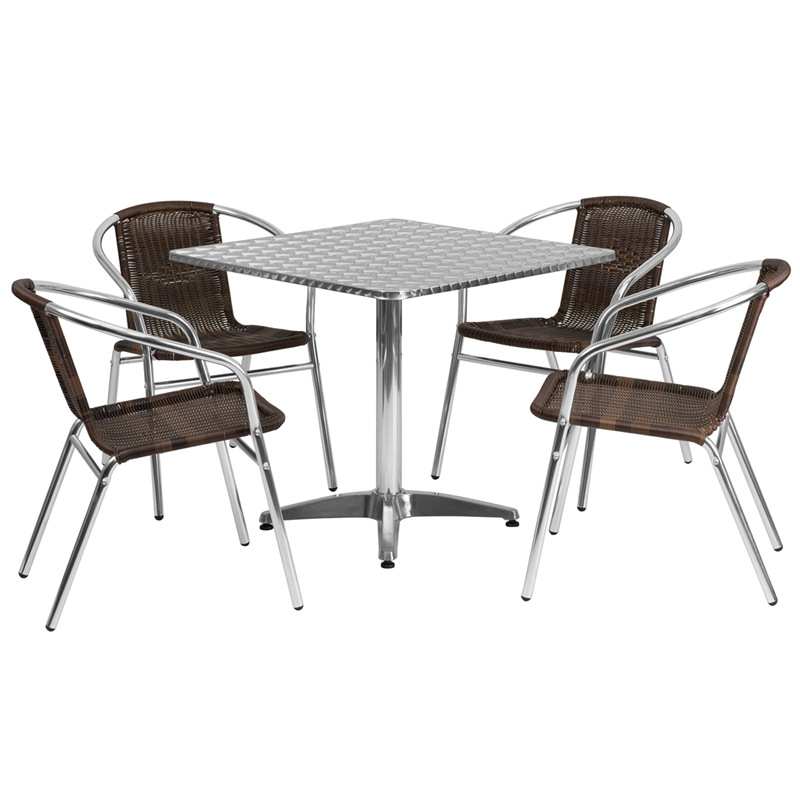
Aluminum
Aluminum is lightweight and resists corrosion, making it a favored material for outdoor garden furniture. Manufacturers construct products from aluminum tubes or by casting. Aluminum patio sets are rustproof and easy to clean, making it a low-maintenance option.
Stainless Steel
Steel is often formed into traditional cast-iron designs. Because steel is more flexible than the heavier iron alloys, steel patio dining furniture and patio sets are more comfortable than iron to many people. Be sure to purchase stainless or galvanized steel patio sets to avoid rusting. Steel weighs less than iron, yet it is very durable and able to handle high traffic and repeated use.
- 204 grade (outdoor grade)
- 304 grade (outdoor grade)
- 316 grade (marine grade)
- 204 grade (outdoor grade)
- 304 grade (outdoor grade)
- 316 grade (marine grade)
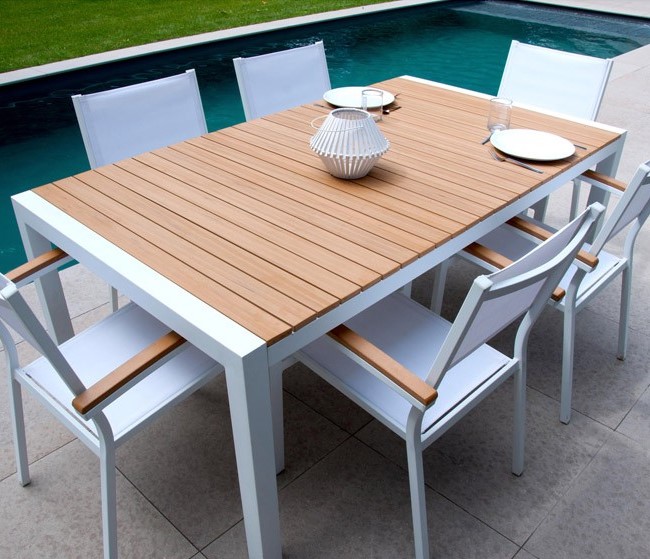

Brass
A yellowish, gold-like alloy of copper and zinc, brass is commonly found on lighting and fixtures like curtain rods, knobs, and sink faucets. Though brass has an upscale appearance, the maintenance is low. Simply clean with mild soap and water. Solid brass can be expensive, look for plated brass for a budget-friendly price.
Copper
Much like bronze, copper is reddish-brown in color and is found on all types of décor like lighting and sinks. Look for copper on high-quality cookware because of its superior heat conductivity. Copper can patina to a greenish-blue over time due to oxidation. To prevent this from occurring (especially if copper is used outdoors), coat with beeswax or carnauba wax and lacquer.
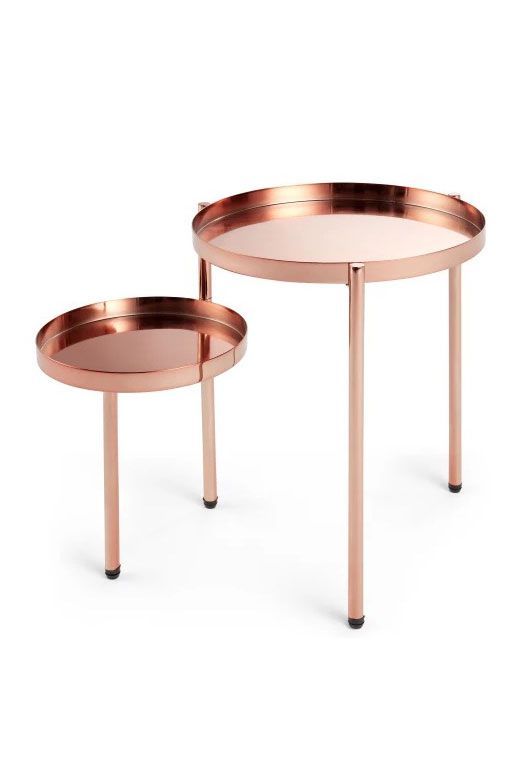
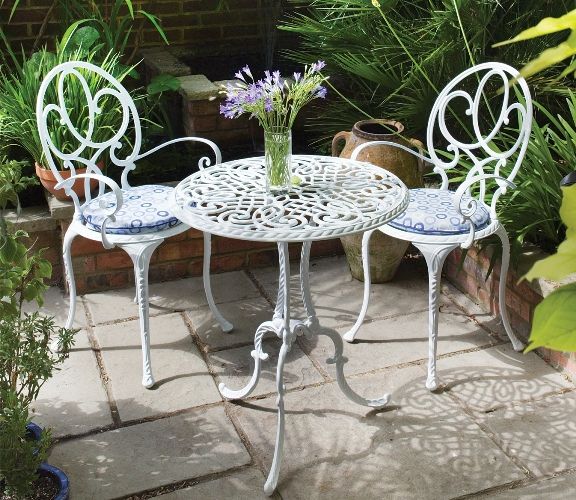
Wrought Iron
Iron has been used by man for millennia. Iron patio furniture, especially cast iron, is heavier than aluminum or steel. Choose cast iron if you don't want the patio-set pieces blowing across the yard during a storm.





